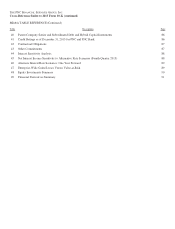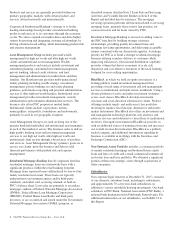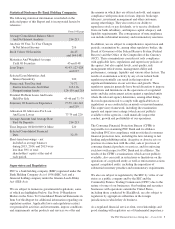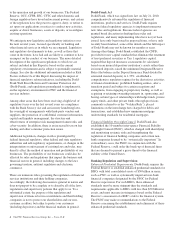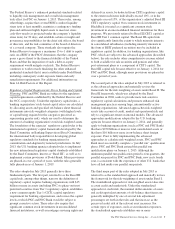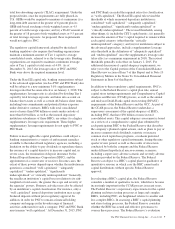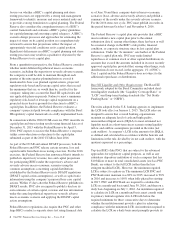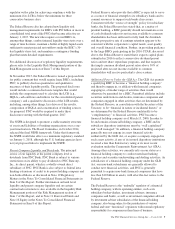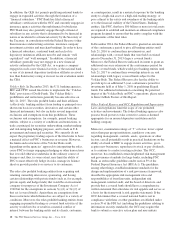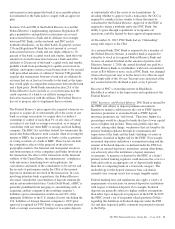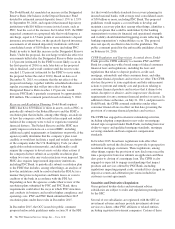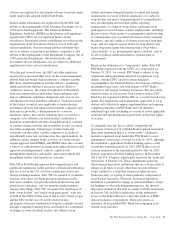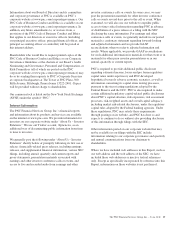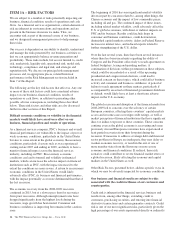PNC Bank 2015 Annual Report Download - page 24
Download and view the complete annual report
Please find page 24 of the 2015 PNC Bank annual report below. You can navigate through the pages in the report by either clicking on the pages listed below, or by using the keyword search tool below to find specific information within the annual report.methodologies that are to be used to calculate the risk-
weighted asset amount for the exposure. The standardized
approach took effect on January 1, 2015.
The risk-based capital and leverage rules that the federal
banking regulators have adopted require the capital-to-assets
ratios of banking organizations, including PNC and PNC
Bank, to meet certain minimum standards. The Basel III rule
generally divides regulatory capital into three components:
CET1 capital, additional Tier 1 capital (which, together with
CET1 capital, comprises Tier 1 capital) and Tier 2 capital.
CET1 capital is generally common stock, retained earnings,
qualifying minority interest and, for advanced approaches
banking organizations, accumulated other comprehensive
income, less the deductions required to be made from CET1
capital. Additional Tier 1 capital generally includes, among
other things, perpetual preferred stock and qualifying minority
interests, less the deductions required to be made from
additional Tier 1. Tier 2 capital generally comprises qualifying
subordinated debt, less any required deductions from Tier 2
capital. Total capital is the sum of Tier 1 capital and Tier 2
capital, less the deductions required from total capital.
As a result of the staggered effective dates of the final U.S.
capital rules issued in July 2013, as well as the fact that PNC
remains in the parallel run qualification phase for the
advanced approaches, PNC’s regulatory risk-based capital
ratios in 2015 were based on the definitions of, and deductions
from, capital under Basel III (as such definitions and
deductions were phased-in for 2015) and the standardized
approach for determining risk-weighted assets. Until PNC has
exited parallel run, PNC’s regulatory risk-based Basel III
ratios will be calculated using the standardized approach for
determining risk-weighted assets, and the definitions of, and
deductions from, capital under Basel III (as such definitions
and deductions are phased-in through 2019). Once PNC exits
parallel run, its regulatory risk-based capital ratios will be the
lower of the ratios calculated under the standardized approach
and the advanced approaches. We refer to the capital ratios
calculated using the phased-in Basel III provisions as the
Transitional Basel III ratios. The Transitional Basel III
regulatory capital ratios of PNC and PNC Bank as of
December 31, 2015 exceeded the applicable minimum levels
in effect for 2015. For additional information regarding the
Transitional Basel III capital ratios of PNC and PNC Bank as
of December 31, 2015, as well as the levels needed to be
considered “well capitalized”, see the Capital portion of the
Consolidated Balance Sheet Review section of Item 7 of this
Report.
The Basel III capital rule requires that banking organizations
maintain a minimum CET1 ratio of 4.5%, a Tier 1 capital ratio
of 6.0%, and a total capital ratio of 8.0% to be considered
“adequately capitalized.” The Basel III capital rule also
includes a capital conservation buffer requirement above the
minimum risk-based capital ratio requirements that banking
organizations must meet in order to avoid limitations on
capital distributions (including dividends and repurchases of
any Tier 1 capital instrument, including common and
qualifying preferred stock) and certain discretionary incentive
compensation payments. The multi-year phase-in of the
capital conservation buffer requirement began on January 1,
2016, and, for 2016, banking organizations (including PNC
and PNC Bank) are required to maintain a CET1 capital ratio
of at least 5.125%, a Tier 1 capital ratio of at least 6.625%,
and a total capital ratio of at least 8.625% to avoid limitations
on capital distributions and certain discretionary incentive
compensation payments. When fully phased-in on January 1,
2019, banking organizations must maintain a CET1 capital
ratio of at least 7.0%, a Tier 1 capital ratio of at least 8.5%,
and a total capital ratio of at least 10.5% to avoid limitations
on capital distributions and certain discretionary incentive
compensation payments.
For banking organizations that are subject to the advanced
approaches (such as PNC and PNC Bank), these higher capital
conservation buffer levels above the regulatory minimums
could be supplemented by a countercyclical capital buffer
based on U.S. credit exposures of up to an additional 2.5% of
risk-weighted assets (once fully phased-in), although this
buffer is currently set at zero in the United States. In
December 2015, the Federal Reserve issued for public
comment a proposed policy statement on the framework and
factors the Federal Reserve would use in setting and adjusting
the amount of the U.S. countercyclical capital buffer. Under
the Basel III rule, covered banking organizations would
generally have 12 months after the announcement of any
increase in the countercyclical capital buffer to meet the
increased buffer requirement amount, unless the Federal
Reserve determines to establish an earlier effective date.
Under the phase-in schedule for the countercyclical capital
buffer, the maximum potential countercyclical capital buffer
amount is 0.625% in 2016, 1.25% in 2017, 1.875% in 2018,
and 2.5% in 2019 and thereafter. When fully phased-in and if
the full buffer amount is implemented, covered banking
organizations would be required to maintain a CET1 capital
ratio of at least 9.5%, a Tier 1 capital ratio of at least 11%, and
a total capital ratio of at least 13% to avoid limitations on
capital distributions and certain discretionary incentive
compensation payments.
In July 2015, the Federal Reserve adopted final rules to apply
an additional risk-based CET1 capital surcharge of between
1.0% and 4.5% (when fully phased-in on January 1, 2019) to
U.S. firms identified as globally systemically important banks
(GSIBs) using a scoring methodology that is based on five
measures of global systemic importance (size,
interconnectedness, substitutability, complexity, and cross-
jurisdictional activity). Based on the methodology, PNC is not
subject to this GSIB surcharge.
In October 2015, the Federal Reserve requested public
comment on proposed rules that would require U.S. GSIBs
and the U.S. operations of foreign-based GSIBs to meet a new
minimum long-term debt requirement and a new minimum
6The PNC Financial Services Group, Inc. – Form 10-K



